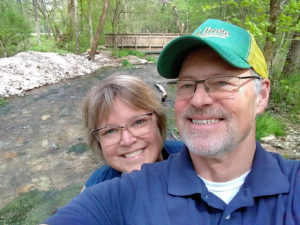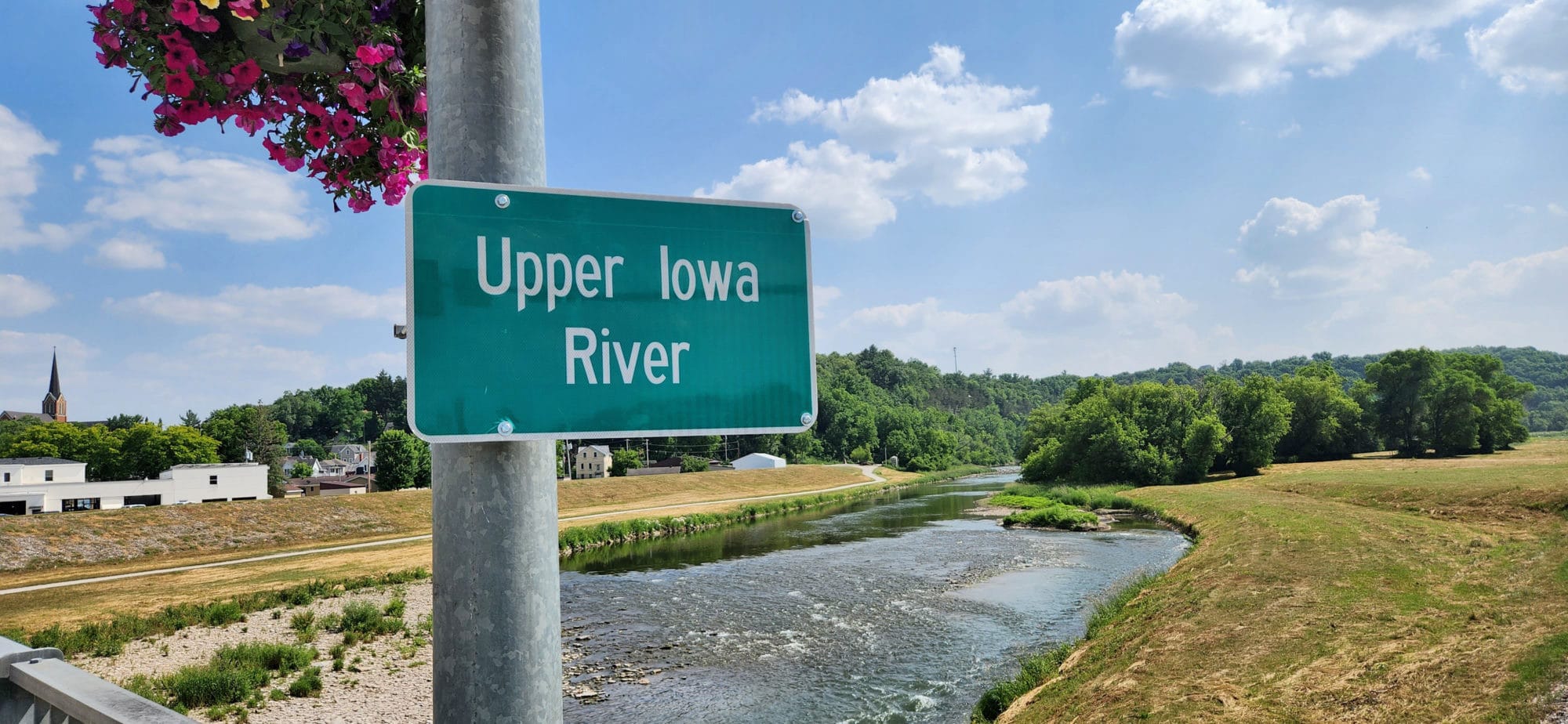The Cycle Continues
Longtime PFI members Steve and Sara Hopkins are innovators in regenerative farming, water conservation and youth education.
Beginnings
For PFI member Steve Hopkins, the story of his career path begins and ends at the Upper Iowa River. As a student at Luther College, in Decorah, Iowa, he channeled his passion for conservation into building his own major, which he called human ecology, a blend of anthropology, biology and agriculture.
After graduating, he took a job with the Center for Rural Affairs’ Small Farm Resources project in Hartington, Nebraska. The year was 1985, not long before PFI’s founding. Part of his work involved driving a small group of farmers to a field day at Dick and Sharon Thompson’s Boone, Iowa, farm. “What they’ll likely remember most is the 1972 Catalina Sedan that I drove across Iowa to get to the field days,” Steve jokes. The earliest PFI members were inspirations for Steve – curious farmers trying new and different methods to improve their operations.
He moved to Wisconsin to pursue his master’s degree in land resources at University of Wisconsin-Madison, but PFI continued to tug at him. While he was there, Dick and Sharon happened to speak at the university. Steve’s path would soon cross with PFI’s again when he coordinated the Farm 2000 project in Poweshiek County, Iowa, a role that involved bringing farmers to some of PFI’s first field days. In 1988, Steve became a member, and shortly after, he and his wife, Sara Hopkins, decided to farm – and to conduct on-farm research in PFI’s fledging Cooperators’ Program.
Rotations, Research, Results
In 1992, Steve and Sara returned to northeastern Iowa and began farming on about 20 rented acres of hilly permanent pasture in Winneshiek County. They raised dairy cattle with intensive rotational grazing, a concept Steve discovered through his studies and had introduced to some central Iowa farmers. At the time, the practice was uncommon in that part of the state. The Hopkinses also researched pasture growth and nutrient density in a rotational system, with funding from PFI’s Sustainable Projects and the Leopold Center for Sustainable Agriculture. Their farm was one of first in northeast Iowa to use rotational grazing – making it an informal test of the new method in their area.
Rotational grazing uses the natural herding behavior of cattle, with fences instead of predators to move them. Steve and Sara divided their farm into 40 paddocks, moving the cattle twice a day to a new paddock with fresh grass and water. They wanted to rely as much on the pasture as possible, purchasing supplemental feed only when necessary. Steve was especially proud of the gravity-based portable water system that got water to nearly all his paddocks.
That system was put to the test almost immediately. In 1993, Iowa experienced 500-year flood conditions, with over 36 inches of rain in three months. Fortunately, the Hopkins farm was able to not only weather the heavy rains but take advantage of them for their operation. “For us, it grew a lot of pasture,” Steve says. “Since we were small and only had 20 cows, we could get by with a relatively short rest period for each paddock.”
As summer progressed, the Hopkinses were able to rely more on the pasture. Cycling through paddocks gave the pasture time to regrow with little mud, and weekly forage analysis showed that the cattle received a steady supply of nutrients. The success caught on with Steve’s landlord and other PFI members. Steve held a PFI field day in August 1993, during which he showed off his system and research. Through 1994, after an early spring reliant on mainly supplemental feed, costs dipped to about half of normal. Between May and July, according to Steve’s Cooperators’ Program report, daily feed costs were less than $1 per cow. As the successful trial came to a close, the growing Hopkins family set their sights on even greener pastures.
A Cardinal Role
In October 1994, Steve and Sara bought a farm in Jasper County, in central Iowa. While they continued dairying for a few years, life began to intercede and the rotational system wasn’t quite the same. “I got an off-farm job,” Steve says. “Sara already had a full-time job [as a school social worker], and we were raising two toddler boys.” They switched from dairy to beef cattle and began raising pastured poultry similarly to Joel Salatin. Twenty years after they began in Decorah, they left farming for good.
In 2000, Steve joined the Iowa Department of Natural Resources to help distribute loans for upgrading septic systems and private wells. His passion and skill for water conservation sent him up the DNR ranks, and in 2007, he was promoted to his current position as the nonpoint-source pollution coordinator. In this role, Steve funds and implements watershed projects around the state that reduce pollution from land runoff. Much of the funding for that work comes from EPA Section 319, a part of the Clean Water Act that funds efforts to manage nonpoint-source pollution in lakes, rivers and streams.
Steve’s lasting legacy in the state is installing signs for watersheds. He chooses which creeks to promote, pays for the signs through Section 319 and has the Iowa Department of Transportation install them. With his help, over 1,200 signs have been installed in 24 counties. In areas with signs, residents are twice as likely to know about their waterways.
“If people know the name of their creek, they are more likely to care about it and change their behaviors and actions to help restore it.”
– Steve Hopkins
One of Steve’s favorite sign projects was especially personal. His sons went to Newton High School, which sits next to waterway that had been known as Sewer Creek, a name with a sad environmental history. “Sewer Creek was the official name because it was the receiving creek for sewage,” Steve says. “Who would care about that creek?” In 2016, he proposed changing the name. Jasper County Conservation Director Keri Van Zante suggested the name “Cardinal Creek,” after the high school mascot.
Since the creek ran alongside the high school, Steve approached biology teacher Courtney Wolken to ask if she would consider discussing the name change with her class. Not only did they discuss the change, but the class – with Steve’s help – took ownership of the project and submitted the paperwork to the United States Board on Geographic Names. When the board approved the name change, Steve installed the signs, one of which is along Interstate 80. “It’s the only creek in Iowa where every road [by it] has a sign,” he says.
To this day, Cardinal Creek is a source of school and community pride. Courtney uses the creek to teach about water quality and spread awareness of Iowa watersheds. “We want our children to not only know about rainforests in Brazil,” Steve says, “but also the creek right outside their door in Iowa.”
Completing the Circle
Although Steve and Sara no longer farm full-time, they still believe strongly in PFI’s mission and vision. Much of Steve’s current work with the DNR involves farmers and landowners, including working with PFI members. “Part of PFI’s challenge is to study and advocate for practices that protect our water,” he says. The Hopkinses feel a kinship for PFI members and look for every opportunity to collaborate. The couple recently moved back to an acreage in Decorah near the Upper Iowa River, where they first met and began their careers. Steve still works as the nonpoint-source pollution coordinator for the Iowa DNR, based in the Canoe Creek watershed.
Steve and Sara’s influence is keenly felt. Lifetime PFI members Dan and Bonnie Beard, Decorah neighbors of the Hopkinses, attended their field day in the early ‘90s. Inspired in part by Steve and Sara’s success, the Beards opted to try rotational grazing on their own farm. Steve says Dan and Bonnie have since “far exceeded what we ever did” with innovating rotational grazing practices.
As he looks forward, Steve hopes to keep the cycle of conservation going, inspiring the next generation of conservationists to learn about and preserve their lakes, rivers and watersheds.


